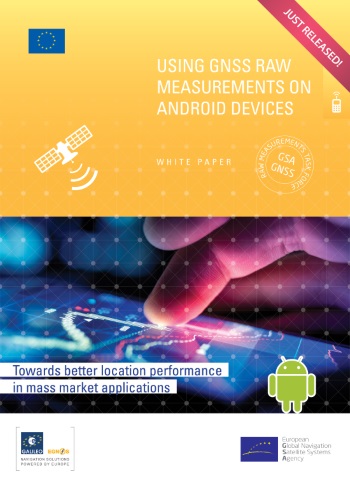A newly published White Paper provides developers with in-depth information on accessing and using GNSS raw measurements with Android, to implement advanced GNSS techniques in mass-market devices.
Google’s announcement that GNSS raw measurements would be made available from Android 7.0 devices (i.e., Nougat) marked the first-time developers had access to carrier and code measurements and decoded navigation messages from a mass-market device.
available from Android 7.0 devices (i.e., Nougat) marked the first-time developers had access to carrier and code measurements and decoded navigation messages from a mass-market device.
The advantages of using these measurements are many. For instance, developers can use this information to implement advanced GNSS techniques in mass-market devices and to compute a position using selected satellites/constellations, optimizing the use of Galileo. When combined with external sensors, raw measurements increase the time when position, velocity and time (PVT) can be computed. More so, Receiver Autonomous Integrity Monitoring provides another layer of integrity in mass-market devices using raw measurements.
“We believe these raw measurements are a real game changer, re-defining the GNSS on our smartphones,” says Lukasz Bonenberg from the University of Nottingham and a member of the GSA’s GNSS Raw Measurements Task Force. “Not only does it allow us to work directly with GNSS data – for post-processing, testing and teaching – but also to find new ways of using GNSS on smartphones, which will lead to new applications that add value to smartphone-based services.”
Despite these advantages, the use of GNSS raw measurements remains limited to testing by GNSS experts. In fact, there are only a handful of smartphone apps that currently use raw measurements. This is, in part, due to the fact that Java coders are usually not GNSS experts, meaning they need help understanding Android raw measurements. Furthermore, the GNSS community typically works with standard formats, such as RINEX and NMEA. As neither of these are available for an Android platform, developers must learn new, non-standard formats.
The reference for using raw measurements
To help bridge this knowledge gap and facilitate the use of GNSS Raw Measurements in mass market applications, the GSA’s GNSS Raw Measurement Task Force has published a White Paper entitled Using GNSS Raw Measurements on Android Devices: Towards better location performance in mass market applications. As the de facto international reference for accessing and using raw measurements, the White Paper aims to present raw measurements to the GNSS community, demonstrate their use through practical examples and increase awareness and use of GNSS in general.
“In the White Paper we present some examples of the main mass-market application areas that could benefit from increased accuracy,” says Gian Gherardo Calini, Head of Market Development Department at GSA. “This represents the starting point, one that should stimulate application developers – and even GNSS experts – to explore using raw measurements and at the same time help optimize the use of Galileo.”
The White Paper includes an in-depth description of raw measurements and how to use them, along with numerous case studies and information on user benefits. It is divided into four parts:
- Part I: overview of the theoretical basics needed to reconstruct GNSS raw measurements using Android, including a basic overview of GNSS, GNSS time references, pseudoranges, navigation messages and position estimation.
- Part II: information on how to access and use raw measurements, including generating pseudoranges and Doppler.
- Part III: a look at the most promising techniques and discussion on the benefits and limitations of each technique.
- Part IV: use cases that may benefit from the increased accuracy and integrity obtained with the use of GNSS raw measurements.
The paper is free of charge and can be downloaded here.
About the GNSS Raw Measurements Task Force
Launched in June 2017 and coordinated by the European GNSS Agency (GSA), the GNSS Raw Measurements Task Force aims to share knowledge and expertise on Android raw measurements and its use, including its potential for high accuracy positioning techniques relevant to mass market applications. The Task Force includes GNSS experts, scientists and market players, all of whom are dedicated to promoting a wider use of these raw measurements.
More information on the Task Force, its members and their work can be found here.
Opportunity for Galileo
Galileo stands to play a big role in the use of GNSS raw measurements. For example, a recent experiment compared the performance of two PVT solutions, one that included Galileo measurements and one that did not. Both solutions were based on raw measurements coming from a smartphone. With raw measurements, users can select which constellation the PVT uses and which satellites are filtered out. This experiment showed that by opting to include Galileo in the PVT solution through the raw measurements, users can easily experience the added accuracy and availability it provides.
“Thanks to the raw measurements, we could compute the Galileo only fix in our lab,” says Airbus’ Moises Navarro Gallardo, who is also a Task Force member. “Smartphone application developers finally have access to more detailed data by satellite, and the White Paper fully describes how to work with this data.”
The experiment, which is further described in the White Paper, also shows how raw measurements enable other GNSS differentiators. For example, Galileo’s Open Service Authentication, a unique feature not found in other constellations, is included in raw measurements. As a result, developers can use this to authenticate navigation messages.
“After testing some of the smartphones that support GNSS raw measurements, it is clear we can further demonstrate the added value of the Galileo constellation in a multi-GNSS mass-market receiver,” adds Task Force member Paolo Crosta from the European Space Agency (ESA).
Media note: This feature can be republished without charge provided the European GNSS Agency (GSA) is acknowledged as the source at the top or the bottom of the story. You must request permission before you use any of the photographs on the site. If you republish, we would be grateful if you could link back to the GSA website (http://www.gsa.europa.eu).